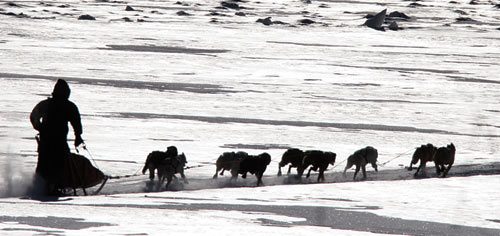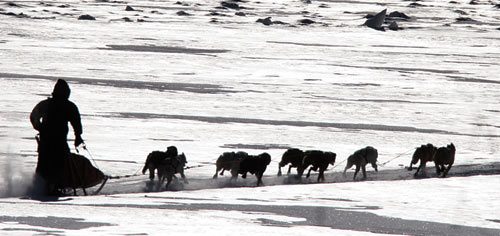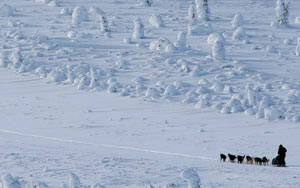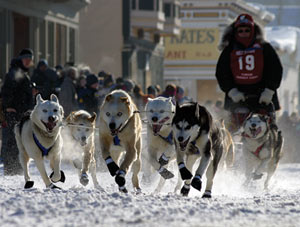

Call of the Wild
“I call her my steering wheel.”
Martin Buser is on the phone. As a dogsledder living in Big
Lake, Alaska, he inhabits a world completely foreign to most
city-dwellers. Instead of workdays filled with computer screens
and email, coffee breaks and stalled freeways, he has icy winter
training runs filled with the panting of dogs muffled by the
silence of snow-blanketed trees; the swish of a sled’s runners and
the sound of his own breath in the dry air.
The “steering wheel” is Bewitched, a promising lead dog. He
has others. Many others. Half of his dogs can take lead, and
Buser has in excess of 70 dogs at any given time. He’s a professional
musher, and one of the most successful. The athlete and
breeder is in that elite crew of perhaps 20 mushers worldwide
who make a living from racing sled dogs.
Buser made his name in the Iditarod, the world’s most
famous sled dog race. With a course stretching more than
1,100 miles through Alaskan wilderness, the race starts on the
first Saturday of March in Anchorage, then finishes in Nome
after crossing two mountain ranges. The race was started in
1973 to celebrate Alaska’s sled trail history and reenact a
famous run in 1925 in which diphtheria serum was rushed to
Nome by sled. Buser has crossed the finish line 23 times, and
won the race four times. He also holds the course record,
completing the trek in under nine days.
To put his accomplishments in perspective: More people
have summited Mount Everest than have crossed the finish
line at the Iditarod.
The musher trains hard. Really hard. Twelve hours or more,
365 days a year. Some days, he’ll spend 14-plus hours travelling
through “the biggest office in the world.” That’s what it
takes to be a contender.
His voice is friendly but self-assured.
“If you don’t do it as committed as I am, you’re not going to
threaten me.”
What does it take to win the Iditarod?
“Mostly a lot of mind over matter,” says the veteran musher.
He says he doesn’t “have quit” in him, using “quit” like it’s a
noun, not a verb.
In race mileage alone, he’s covered enough terrain to equal
two circumnavigations of the globe. And over the course of the
Iditarod, each of his dogs’ paws will touch the ground two million
times. His dogs aren’t much for quitting either.
But winning is never simple, even for champions. The first five
or six days on the trail are easy, says Buser. At one point or
another, however, you’re going to have to push. Buser pushes
himself, he pushes his family (he’s married, with two kids), and
he pushes his dogs.
Iditarod Trail Headquarters is located in Wasilla, an hour or so
down the No. 3 Highway from Anchorage. Tourists visit the site
by the busload. It is, in a sense, the Mecca of mushing.
Chas St. George is the public relations director for the Iditarod.
This race is big by any measure: big landscape and big mileage,
sure, 
the event, St. George says, race vets conduct more than 10,000
checks of dogs; dogs consume 10,000 to 12,000 calories each per
day (and you thought your dog ate a lot!); 1,800 volunteers help
make the whole thing happen; and the Iditarod website has more
than 500 million page views during the event, including 2.5 million
new users.
Success at a race in which any one of the top 30 teams has a
chance at winning comes down to developing a strategy and
sticking with it, says St. George: “You plan your work and you
work your plan.”
Every plan is based upon developing a strong team. The dogs
are in excellent physical shape, but the competitive nature of this
race has forced the mushers to follow suit. Mushing has always
been a tough workout, but today’s top racer, says St. George,
could be compared to an ultra-marathoner. On uphills, the
human team member pushes, and even on the flats, the driver
sometimes has to pitch in. Peaking for the race includes developing
a bond between human and canine that’s stronger than
cement.
Of course, any event in which dogs are worked hard will invite
criticism. It’s one thing for a person to decide to push his or her
limits, but it’s a different situation when a dog owner encourages
his or her dogs to push their limits.
The Iditarod’s chief veterinarian is responsible for protecting the health and well-being of more than a
thousand high-performance dogs. For 12 years, that task has fallen to Stuart Nelson, Jr.
“One of my primary goals is to educate the mushers,” he says. In the early days of the race, the relationship
between vets and racers was not as harmonious; a cops and robbers scenario, he says, in which
mushers felt like vets were trying to pick on them. Nelson has made a concerted effort to change
that dynamic. “I get a lot of really positive feedback from the mushers.”
The Iditarod’s health system is “pretty elaborate,” says the vet. Beginning a month before the
race, every competing dog has blood work done and undergoes an EKG to test heart function.
Then, two weeks from the starting line, each dog must complete a physical exam. In addition, all
of the dogs are dewormed and must be micro-chipped. Chips are checked at the start line to make
sure the dogs in the harnesses are the same dogs that underwent physical testing.
More than 30 vets work as volunteers for the race. The goal at each checkpoint is to give each
dog a quick physical exam. Results are jotted into a “vet book” which the musher must present at
the next checkpoint. Mushers are encouraged to look for warning signs that a dog might need to
be dropped, such as a change in gait or a loss of enthusiasm.
Dogs die in this race. That’s the harsh reality. The Iditarod’s average over the past few years is two
canine fatalities per race. The number has crept up as the field has grown. Causes range from traumatic
accidents to physiological problems, such as overheating (the race is in March and these dogs are used to
running hard through the dead of winter), ulcers, and myopathy, in which potassium released from the
breakdown of muscle causes sudden heart failure.
Tough as the Iditarod may be, another race claims the title of the
“toughest sled dog race in the world,” and Julie Estey, executive
director of Yukon Quest’s Fairbanks, Alaska, office offers a number
of justifications for that boast.
The Yukon Quest race, which has been run every year since
1984, is a month earlier than the Iditarod, when it’s darker and
colder. It has fewer than half the checkpoints, requiring mushers to
carry more weight and be more independent. And the trail gains
and loses more elevation as racers travel between Whitehorse,
Yukon, and Fairbanks, Alaska.
The idea for the Yukon Quest, which covers a thousand miles of
remote backcountry, was hatched in a bar called the Bull’s Eye
Saloon, says Estey. Leroy Shanks, the fellow who came up with it,
considered Fairbanks the heart of mushing country,
and wanted to create a race that would rekindle interest in the historical
goldrush routes from Canada to Alaska.
“We are very fortunate to have a lot of wide open space,” says
Estey, explaining why North America is home to the world’s two
longest races. It’s wide open terrain that once boasted a much higher
population at the end of the nineteenth century when gold was
discovered in the Yukon. Settlement was based on waterways, she
says, as there were no roads to remote areas. The Yukon Quest
route takes mushers to one village that, to this day, still doesn’t
have road access in the winter. There are areas in the territory that
once boasted thriving towns and are now just a lone heated
shack—still a welcome destination for mushers exhausted from a
day of battling through swirling snow and deep drifts.
The Quest attracts a slightly different racer than the Iditarod. In
addition to mushers that are world class it also includes talented
racers who are still living a subsistence lifestyle off the land. Their
dog teams aren’t just for racing; these are working dogs who still
get worked. Many of the teams don’t have the cash to mount an
Iditarod challenge. While sleds these days are typically made of
high-tech materials, you can still encounter an old-style ash sled
(the old ones are easier to fix on the trail, too). Clothing for a rookie
might be “third-hand” army surplus, says Estey.
The Quest is lower in profile than the
Iditarod, with a smaller field and a smaller
purse, but Estey seems to hold little enmity
towards her race’s rival. She says the
Iditarod’s success has done an “amazing
service” for the sport. And with a recent
influx of cash from the Yukon territorial government
boosting the first-place purse to
$40,000, Estey hopes to see more of the
world’s top racers shooting for first place at
the Yukon Quest, rather than “top ten” at the
Iditarod.
Lance Mackey has won the Yukon Quest
two years running. He’s also the only person
to win the Quest and also finish in the top
ten at the Iditarod in the same year. The end of the former is only ten days
before the start of the latter.
Mackey’s tales from the trail are straight out of a Jack London book.
“They’re all my buddies—these are my family members,” he says of his
team. Being on the trail is “emotional.” Mackey uses the word a number of
times. He describes being on “day five with no sleep,” when suddenly it hits
you that you might be in the top ten and you find yourself getting teary-eyed.
People who’ve never done these endurance races don’t know the “solitude of
the whole thing,” he says, or the bond that’s forged when you’re
sleeping beside your dogs, and you rely on each other for survival.
And sometimes not everyone does survive.
On the Iditarod three years ago, Mackey was two hours into an
eight-hour stretch, crossing a frozen lake, when one of his dogs
went down and didn’t get up. Ultimately, the dog died.
The horror of the situation was compounded by having to
place the dead dog on his sled, where two live littermates were
already resting, having been dropped from the team. Mackey got
the sled moving again but he was devastated.
“My whole world was falling apart,” he says. It took everything
in him to keep going. To this day, it remains the worst
moment in his mushing career. As far as he’s concerned, two
Yukon Quest victories don’t “zero out” the loss of his dog. He
takes some comfort in the thought that health defects sometimes
strike down even human athletes in the midst of doing what they
love.
Mackey rejects the idea that this kind of mushing is inherently
cruel. A team that didn’t love to pull wouldn’t be competitive. He
acknowledges that in any population of people, there will be
“bad seeds,” but his definition of cruelty to animals is a Siberian
Husky cooped up in an apartment in Phoenix, Arizona.
“[Mushing] is what they’re bred for,” he says, “this is what
they love to do.”
■
Eric Sparling has written for The Globe and Mail, The Toronto Star, Nuvo, ModernDog
and numerous other publications.
Join the newsletter and never miss out on dog content again!
"*" indicates required fields
By clicking the arrow, you agree to our web Terms of Use and Privacy & Cookie Policy. Easy unsubscribe links are provided in every email.